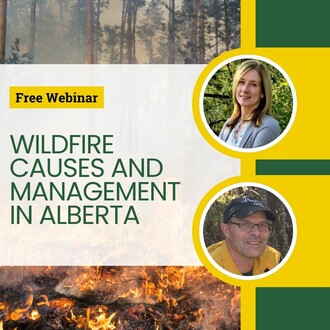Wildfire Causes and Management in Alberta webinar overview

The Alberta Land Institute (ALI) held the first of a series of lunchtime webinars this past Tuesday. The webinar series aims to encourage knowledge sharing and discussion on land use related issues in Albert and beyond.
The first session was about wildfire causes and management in Alberta and featured guest speakers Jen Beverly, an Associate Professor at the University of Alberta in the Renewable Resources Department of the Faculty of Agricultural, Life and Environmental Sciences, and Dave Schroeder, the Capability Development and Analysis Program Lead at Alberta Forestry and Parks, Forestry Division.
The session was moderated by Sandeep Agrawal, Professor in Earth and Atmospheric Sciences at the University of Alberta, and Director of ALI.
The one hour session included presentations from both guest speakers on their published research “Alberta’s 2023 wildfires: context, factors and futures” followed by a Q and A session moderated by Sandeep.
The webinar recording and transcript will be made available here on the ALI website at a later date. Keep reading for an overview of the webinar session.
After an introduction from ALI’s communications officer, Aysha Wu, Sandeep introduced the guest speakers.
Presentation from Jen Beverly
Jen Beverly presented first and provided the purpose of the research and an overview of the conditions that facilitated Alberta’s 2023 wildfire season.
As a response to the increase in wildfire across Canada, Beverly and Schroeder’s research was conducted at the request of the Canadian Journal of Forced Research which invited researchers from different regions to write perspective papers on wildfire in different regions.
The series of 4 papers will be published in a special issue and, in addition to Beverly and Schroeder’s paper on Alberta, will include papers on British Columbia, Quebec and the maritimes.
Beverly approached Schroeder to collaborate to provide an operational side to the research.
The project consisted of examining data about wildfires in Alberta spanning the last hundred years. Beverly emphasized that some of the older data was less reliable in terms of the number of fires burnt, but that the relevant information is not the amount, necessarily but the area burned.
While the 2023 wildfire season had been referred to in the media as novel, the data suggests that the behaviour of individual fires in 2023 was typical for the region, but that large fires – fires that burned 10,000 heaters or more – were more numerous in 2023 than previous years.
Beverly pointed out that large fires are not unusual in the region, referencing the Horse River fire of 2016, Donny Creek last year and the Chinchaga fire of 1950. However, the 2023 season differed from previous outbreak years due to a high number of large fires starting over a short period of time in early May.
These early large fires started as a result of a combination of unusual lightning activity, warming as a result of climate change, drought and other unusual weather patterns.
The sudden influx of large fires overwhelmed the province's resources and prevented fire suppression.
Presentation from Dave Schroeder
Following Beverly’s presentation, Dave Schroeder’s presentation outlined Alberta Forestry and Parks’ wildfire management strategies, followed by an overview of how Alberta’s resources were affected by the 2023 wildfire season.
Schroeder explained that Alberta Forestry and Parks’ wildfire management consists of prevention and response.
Prevention includes FireSmart disciplines such as reducing fire danger through managing potentially flammable vegetation, and education and enforcement programs. These programs and staff work with industry and the public to bring awareness to human caused ignition. Fire ban programs and information dissemination also fall under this category.
There is more information about prevention on the FireSmart website.
Wildfire management response involves anticipation and preparation.
Wildfires are forecast through a number of methods such as daily weather briefings and predictions from fire behaviour analysts in order to pre position resources, such as crews and aircraft, for quick response.
Detection is key to a quick response and is carried out by 100 human occupied lookouts, aerial and ground patrols and hotline reports from the public and industry. Alberta also utilizes technology for detection, including drones, night video and helitankers
Detection is followed by a rapid initial attack. The initial attack has a 90-95% success rate. Schroeder notes that early suppression is the most effective way of reducing costs, protecting value and preventing fire growth.
The availability of resources greatly affects the efficacy of these programs.
In the case of the 2023 wildfire season, the number of fires exceeded the capacity of Alberta’s resources so the province had to rely on out of province support. Due to a limited amount of resources within Canada, firefighters were flown in from different countries.
Unfortunately, importing resources is costly and depends largely on whether or not other countries have resources to spare.
Q&A
During the Q and A session, Schroeder responded to a question about factors that lead to the 2024 Jasper wildfire. Schroeder explained that the use of fire exclusion – preventing fire regardless of its cause – in the Jasper area has led to an increase of forest cover in the region.
Aside from naturally occurring fires, fire was also historically used by indigenous peoples as land management. Without any fire in the region, the forests have expanded.
Schroeder proposed that managing vegetation differently on a large scale could help mitigate future fires in the region.
A recording of the session will be posted on ALI’s website later this month including the entire Q and A session.
Thank you to all attendees and guest speakers. Keep an eye out for announcements for future webinar sessions.